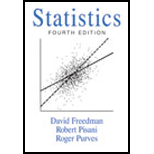
(a)
Define the conclusion based on the provided information.
(a)
Explanation of Solution
Based on the given information, out of 12,866 men aged 35–57 at high risk of heart disease, 6,428 subjects were randomly assigned to the intervention group and the remaining 6,438 men were assigned to the control group.
Let x represent the intervention group and y represent the control group.
The following values are known:
It is observed that the sample means and sample standard deviations are approximately same in both groups. This indicates that the groups are approximately the same prior to the application of the treatments. Therefore, it may not be expected that any lurking variables affect the results of the experiment.
(b)
Describe the conclusion based on the provided information.
(b)
Explanation of Solution
Let x represent the intervention group and y represent the control group.
The following values are known:
It is observed that the sample means and sample standard deviations are both lower in the intervention group in comparison to the control group. This indicates that the treatment group appears to have been effective. The average blood pressure appears to have decreased in the intervention group, while the blood pressure was approximately the same in the two groups preceding to the treatments.
(c)
Delineate the conclusion based on the provided information.
(c)
Explanation of Solution
Let x represent the intervention group and y represent the control group.
The following values are known:
It is observed that the sample means and sample standard deviations are approximately the same in both groups. This indicates that the groups are approximately the same prior to the application of the treatments. Therefore, it may not be expected that any lurking variables affect the results of the experiment.
(d)
Label the conclusion based on the provided information.
(d)
Explanation of Solution
Let x represent the intervention group and y represent the control group.
The following values are known:
It is observed that the sample means and sample standard deviations are both lower in the intervention group in comparison to the control group. This indicates that the treatment group appears to have a decreased serum cholesterol level. The average serum cholesterol level appears to have decreased in the intervention group, while the serum cholesterol level was approximately the same in the two groups preceding to the treatments.
(e)
Explain the conclusion based on the provided information.
(e)
Explanation of Solution
Let x represent the intervention group and y represent the control group.
The following values are known:
It is observed that the sample proportion of smoking is approximately the same in both groups. This indicates that the groups are approximately the same prior to the application of treatments. Therefore, it may not be expected that any lurking variables affect the results of the experiment.
(f)
Explain the conclusion based on the provided information.
(f)
Explanation of Solution
Let x represent the intervention group and y represent the control group.
The following values are known:
It is observed that the sample proportion of smoking is lower in the interval group in comparison with the control group. This indicates that the treatment group appears to have decreased the likelihood to smoke as the proportion of smoking appears to have reduced in the intervention group. On the other hand, the proportion of smoking was approximately the same in the two groups preceding to the treatment.
(g)
Elucidate the conclusion based on the provided information.
(g)
Explanation of Solution
From the information provided, 211 men died after 6 years in the intervention group and 219 men died after 6 years in the control.
Since the difference between two groups is 8
Therefore, this indicates that the treatment appears to have no effect on the death rate as the number of deaths remained approximately the same in the two treatment groups.
Want to see more full solutions like this?
Chapter 29 Solutions
Statistics
 MATLAB: An Introduction with ApplicationsStatisticsISBN:9781119256830Author:Amos GilatPublisher:John Wiley & Sons Inc
MATLAB: An Introduction with ApplicationsStatisticsISBN:9781119256830Author:Amos GilatPublisher:John Wiley & Sons Inc Probability and Statistics for Engineering and th...StatisticsISBN:9781305251809Author:Jay L. DevorePublisher:Cengage Learning
Probability and Statistics for Engineering and th...StatisticsISBN:9781305251809Author:Jay L. DevorePublisher:Cengage Learning Statistics for The Behavioral Sciences (MindTap C...StatisticsISBN:9781305504912Author:Frederick J Gravetter, Larry B. WallnauPublisher:Cengage Learning
Statistics for The Behavioral Sciences (MindTap C...StatisticsISBN:9781305504912Author:Frederick J Gravetter, Larry B. WallnauPublisher:Cengage Learning Elementary Statistics: Picturing the World (7th E...StatisticsISBN:9780134683416Author:Ron Larson, Betsy FarberPublisher:PEARSON
Elementary Statistics: Picturing the World (7th E...StatisticsISBN:9780134683416Author:Ron Larson, Betsy FarberPublisher:PEARSON The Basic Practice of StatisticsStatisticsISBN:9781319042578Author:David S. Moore, William I. Notz, Michael A. FlignerPublisher:W. H. Freeman
The Basic Practice of StatisticsStatisticsISBN:9781319042578Author:David S. Moore, William I. Notz, Michael A. FlignerPublisher:W. H. Freeman Introduction to the Practice of StatisticsStatisticsISBN:9781319013387Author:David S. Moore, George P. McCabe, Bruce A. CraigPublisher:W. H. Freeman
Introduction to the Practice of StatisticsStatisticsISBN:9781319013387Author:David S. Moore, George P. McCabe, Bruce A. CraigPublisher:W. H. Freeman





